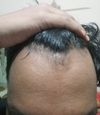community Here are the results from my journey! I used saw palmetto tablets instead of Finasteride(I was afraid of using it), 5% Minoxidil spray and Derma Pen once a week 1.5mm.
The user shared their positive hair regrowth experience using saw palmetto tablets, 5% minoxidil spray, and a Derma Pen. The conversation debates the effectiveness of saw palmetto versus finasteride, with some advocating for natural treatments and others emphasizing the proven results of finasteride and minoxidil, often in combination with microneedling.
